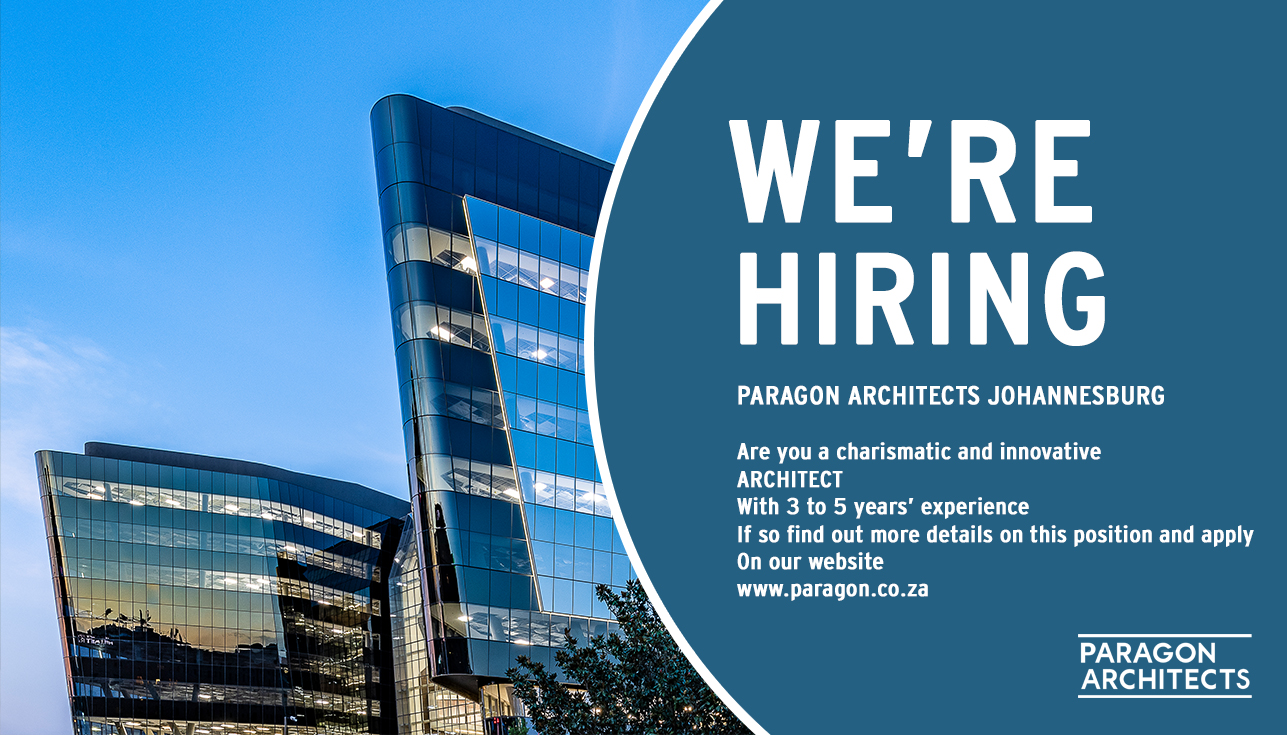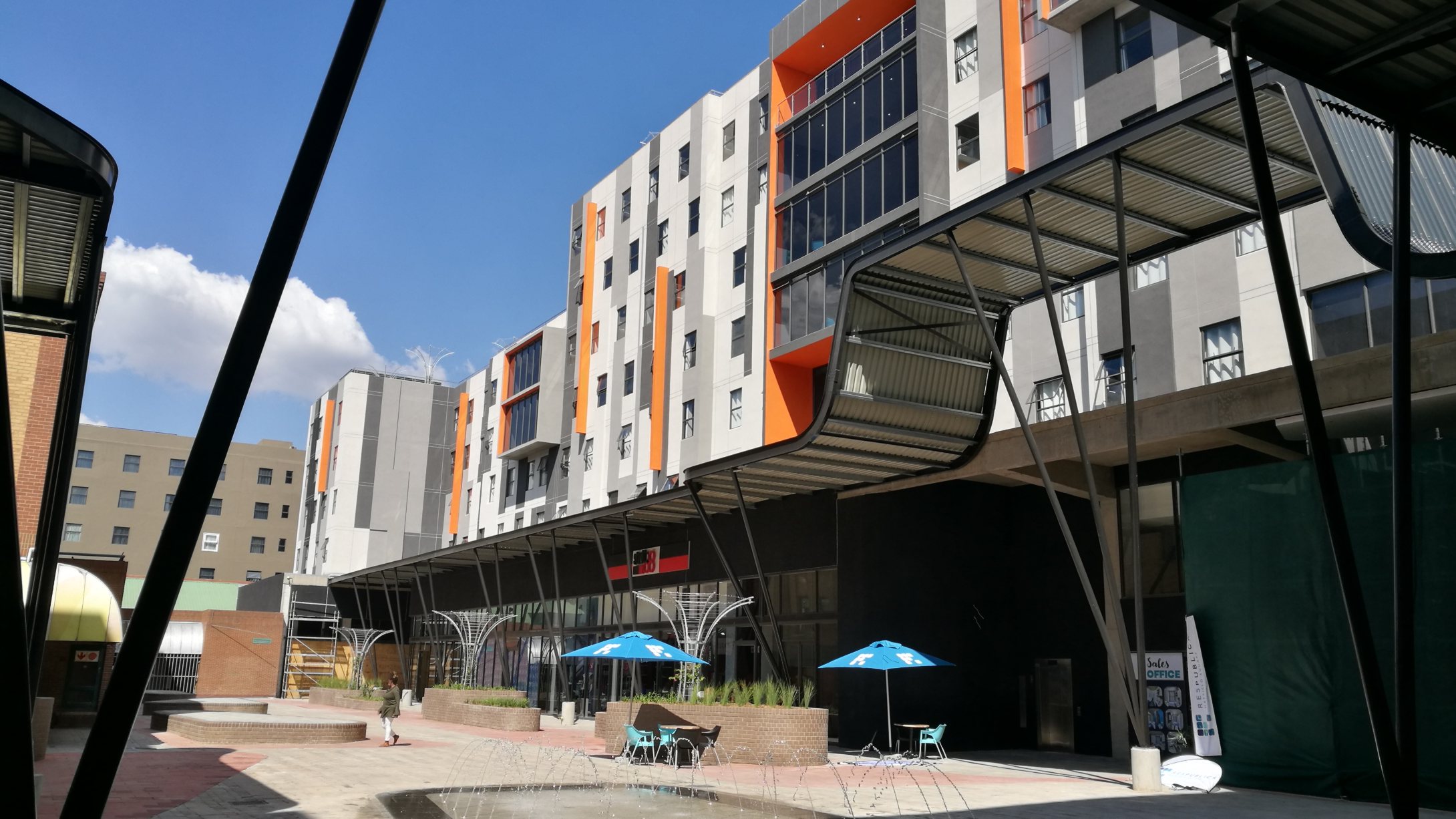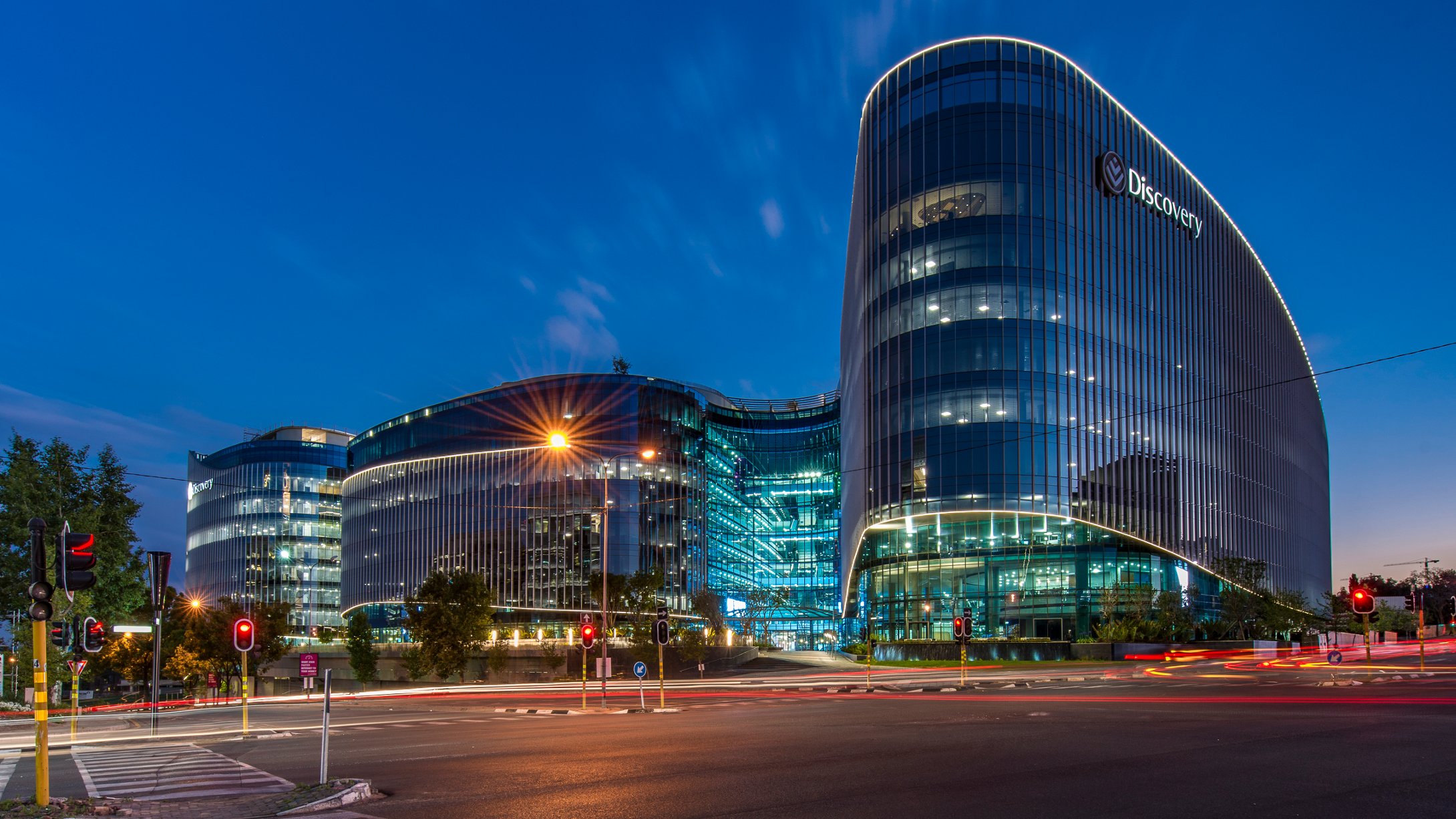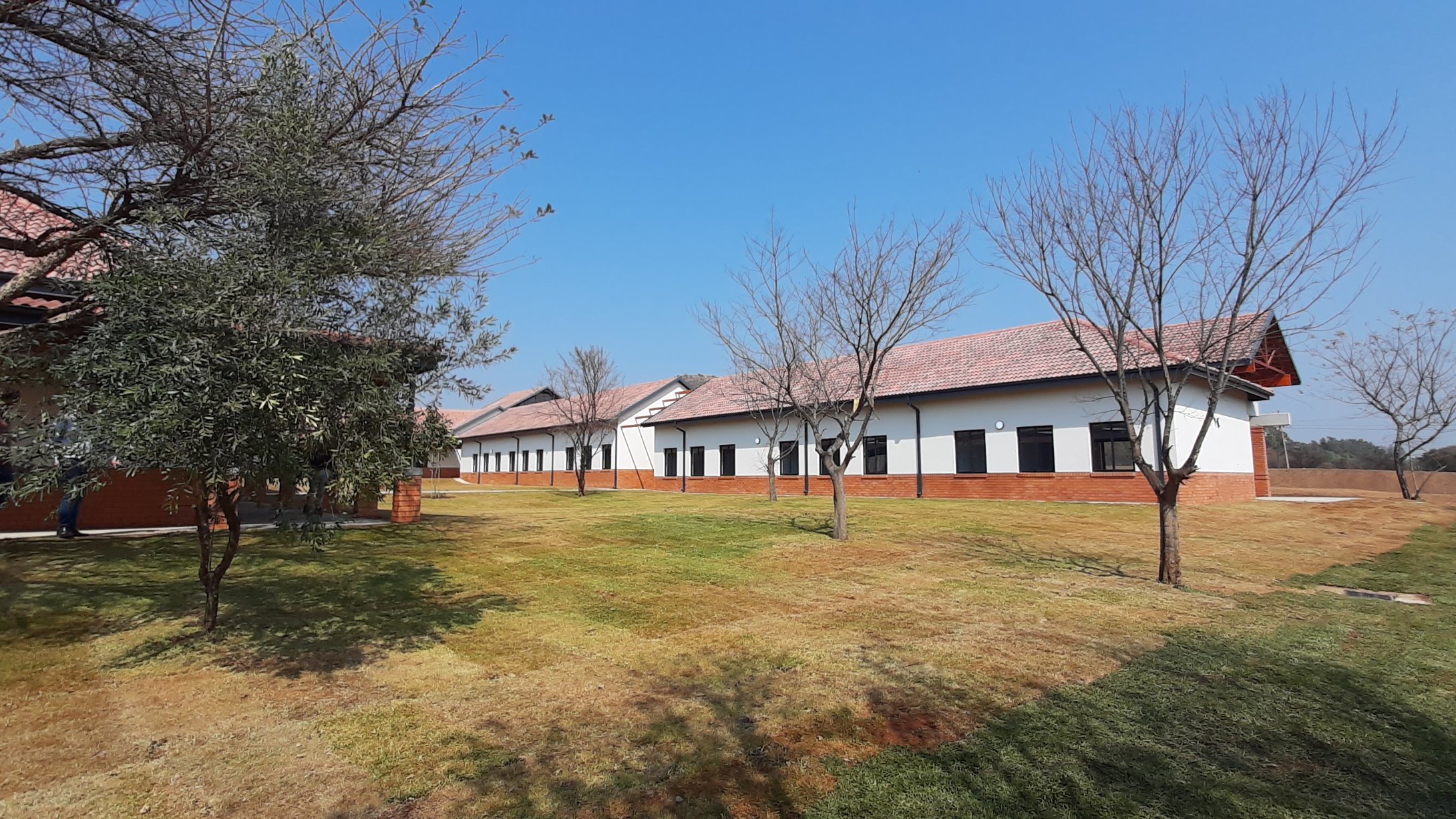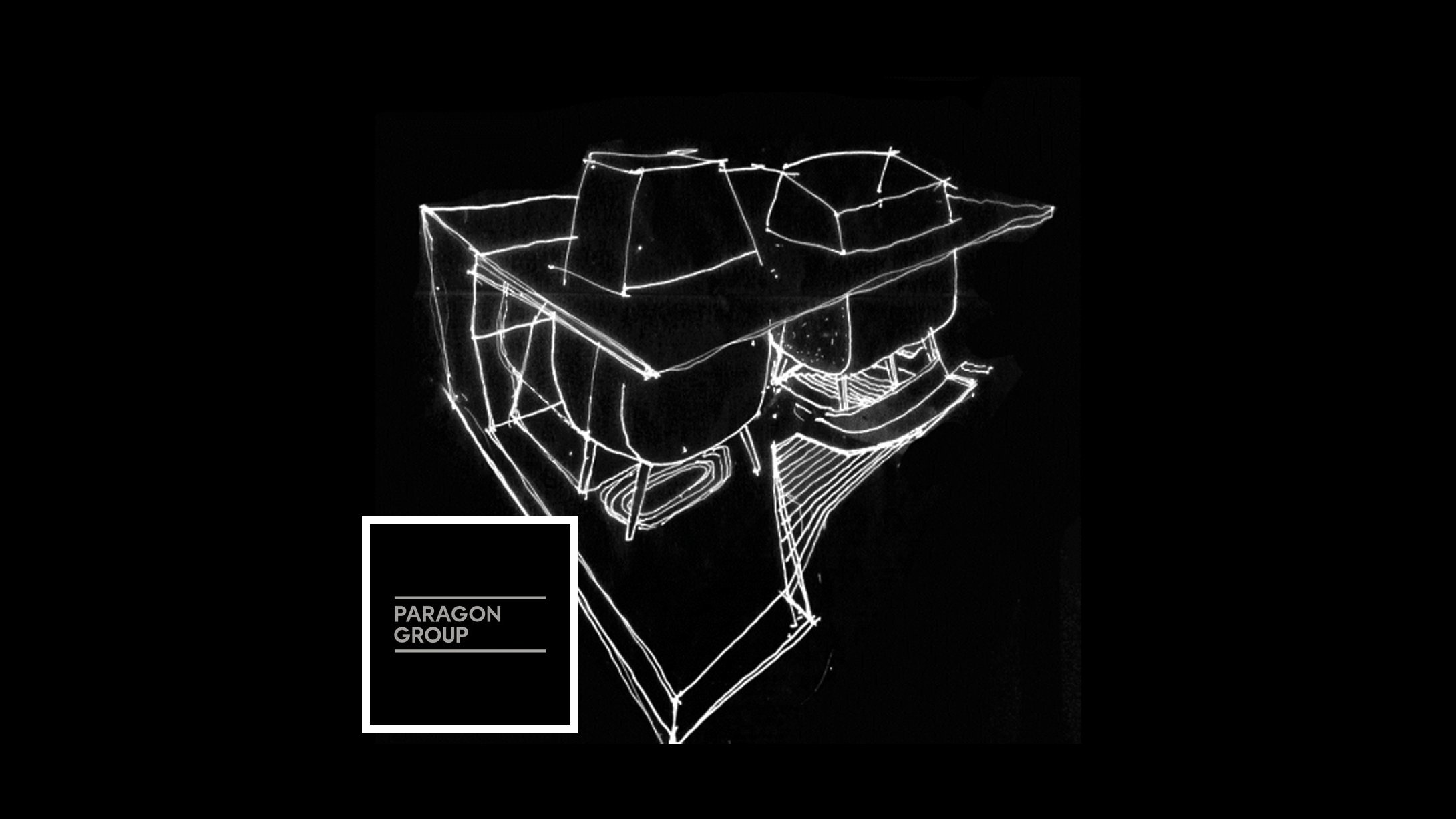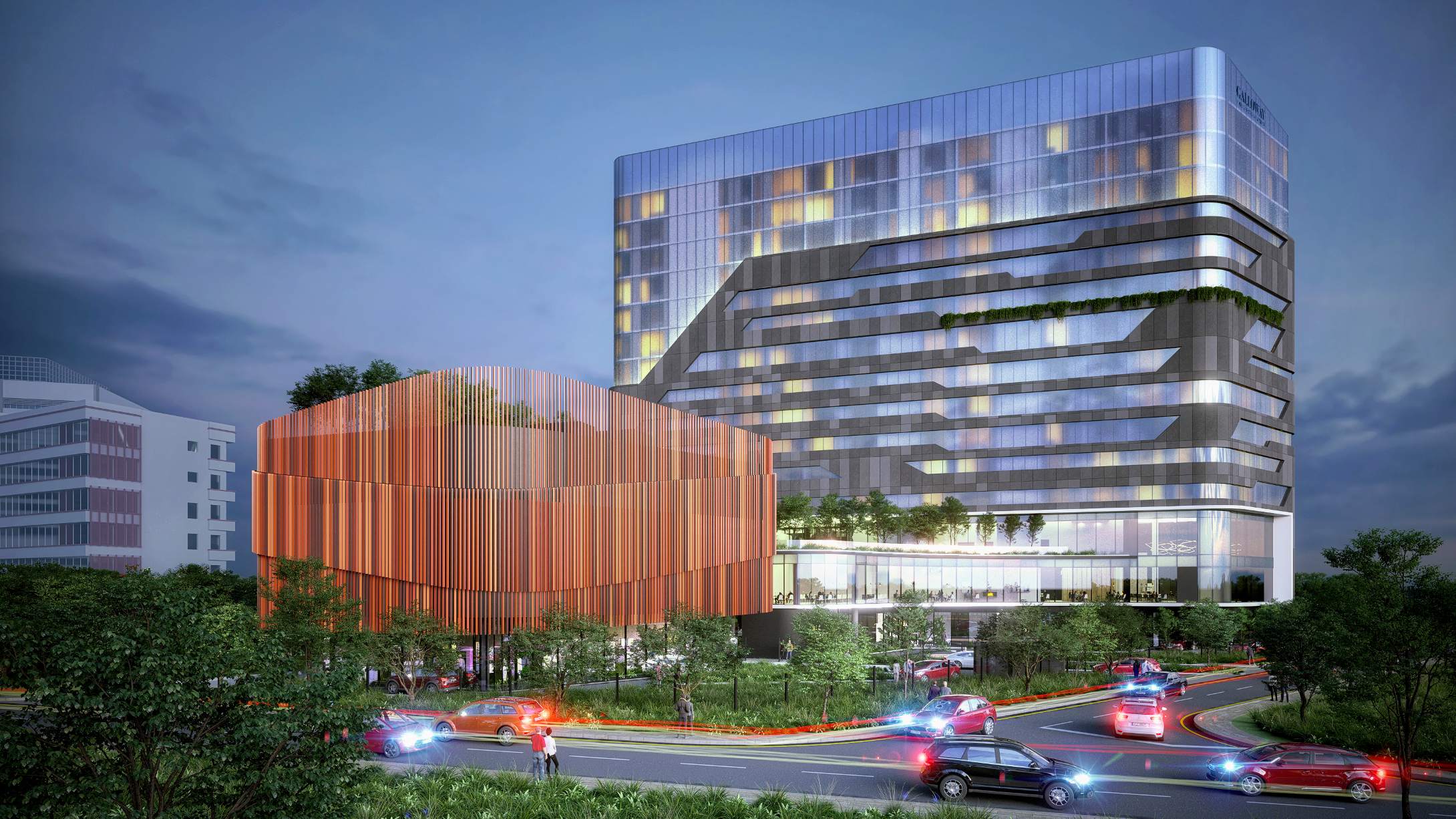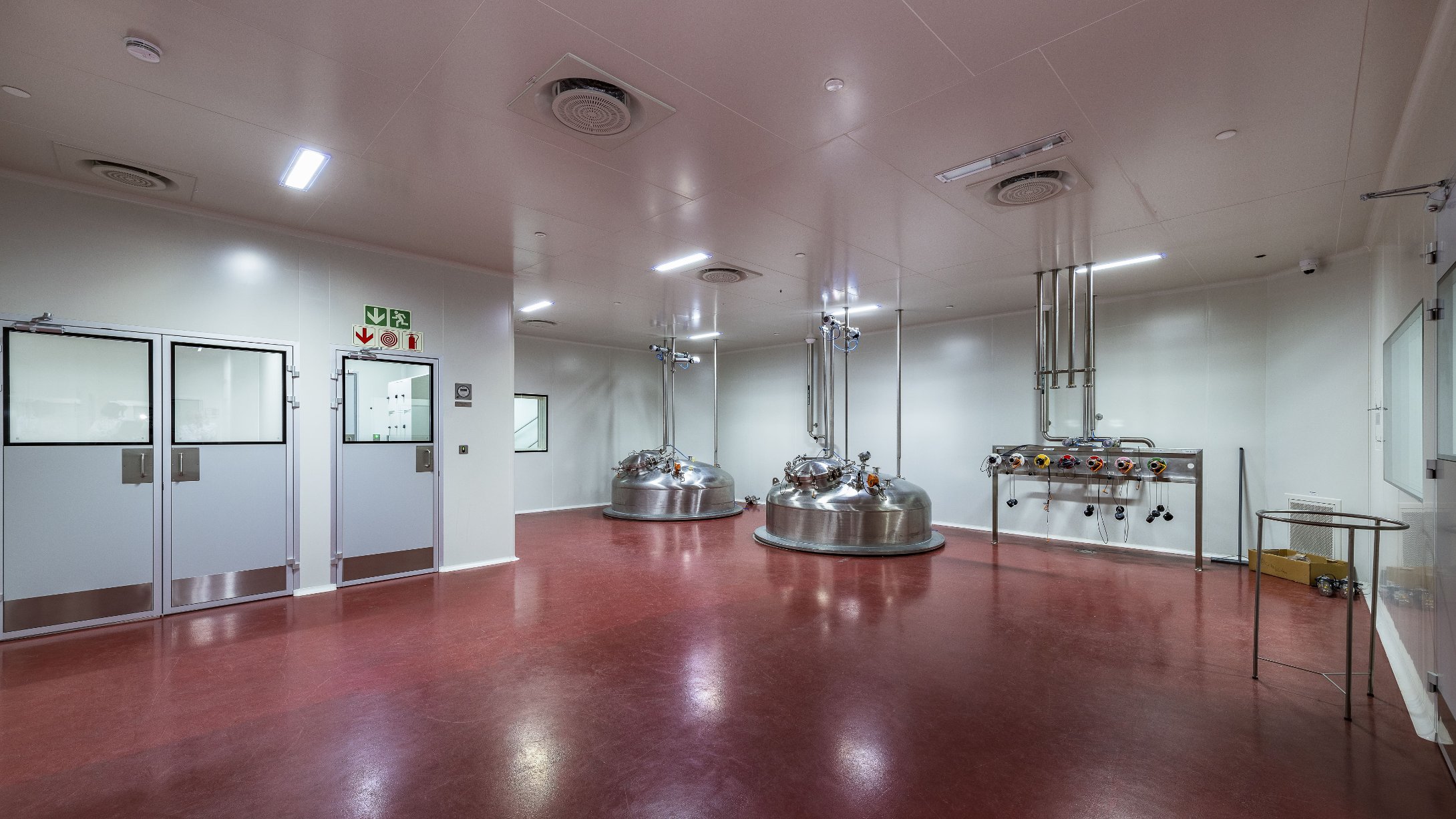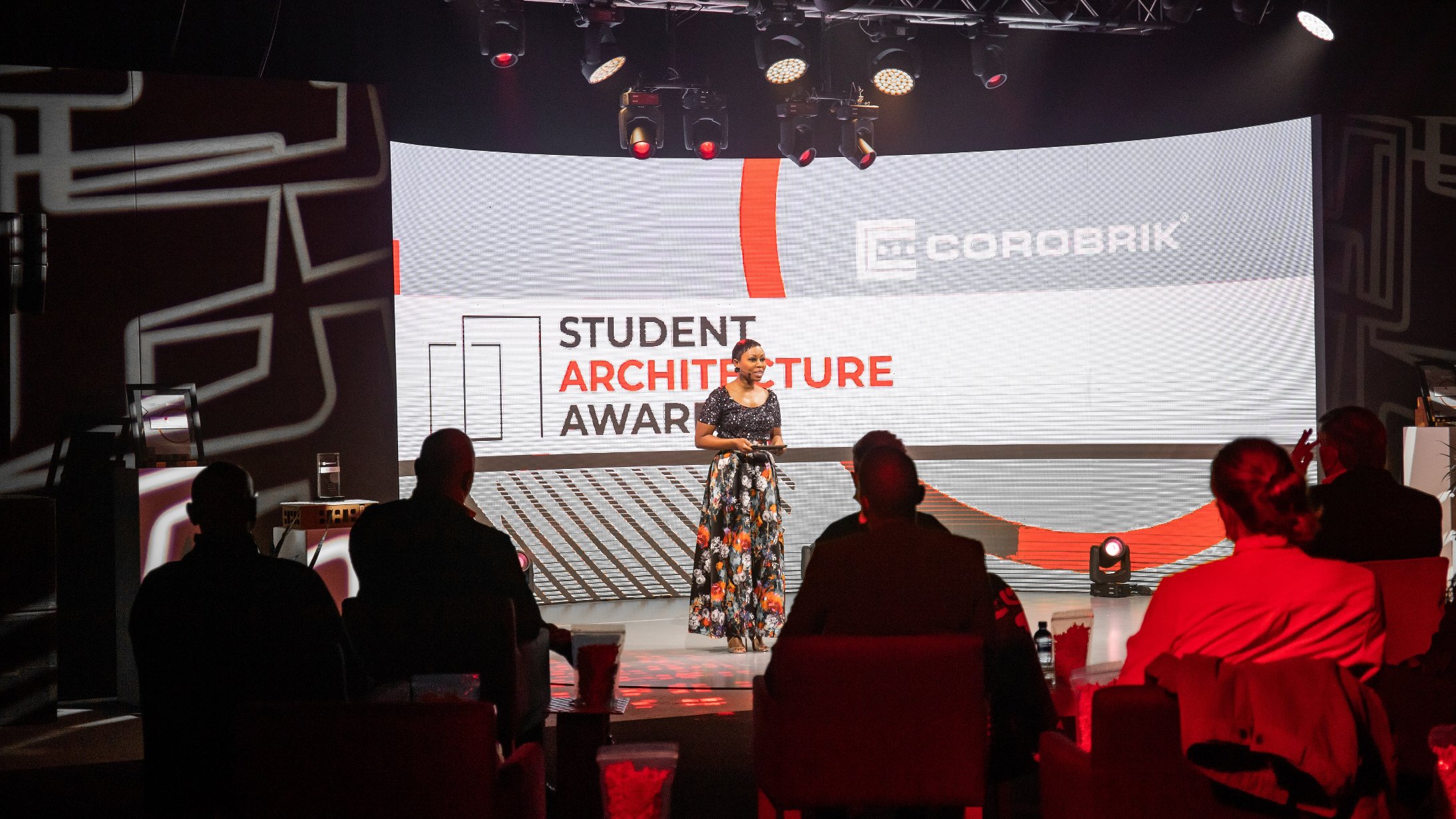Careers: New 2022 positions at the Paragon Group
By Paragon Media
- 0
- 0
- News
- 05 Apr
Paragon Architects Cape Town is looking for an Architect with 3 – 5 Years’ experience, as well as a Candidate Architect with 1-2 Years.
If you can answer the following 5 questions with a yes, then you might be what we are looking for you:
1. Is Revit your first Language?
2. Do you have the urge to master your field?
3. Do you adore a good detail?
4. Does excellence drive your deliverables?
5. Is Accuracy and Speed your middle names?
If all these questions ring true for you then this is the position for you
Must haves:
Excellent Revit Experience
To apply please send the following:
• CV
• Design portfolio
• Technical Portfolio
• University Marks
To: joinus@paragon.co.za with the Reference/Subject Line: PACPT_ARC/CA_02
The closing date for applications is the 15th of April 2022
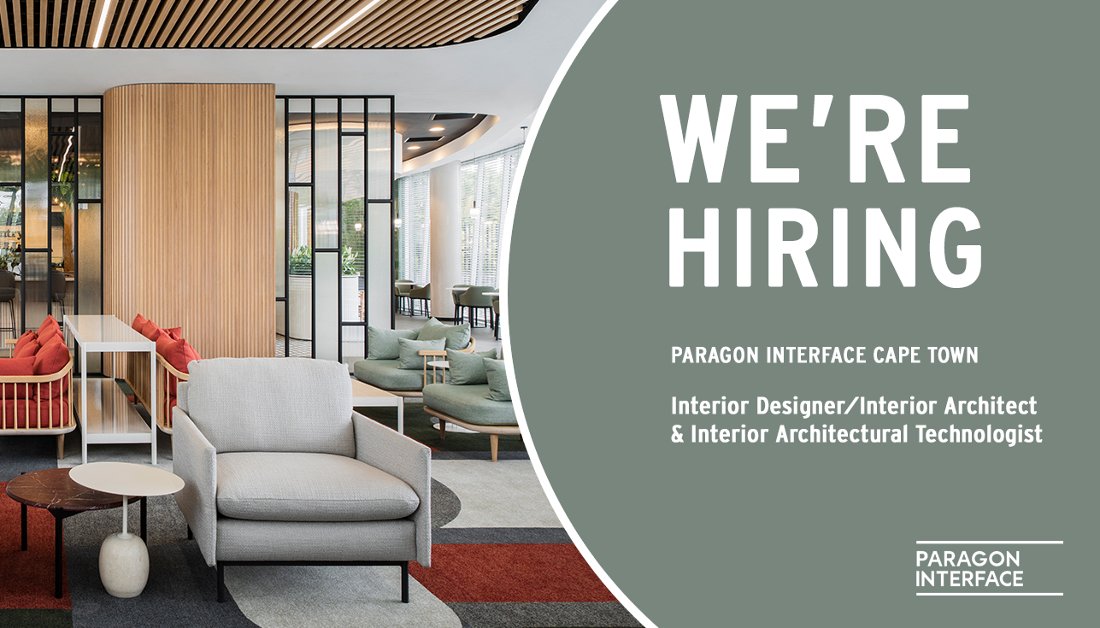
Paragon Interface Cape Town is looking for an Interior Designer/Interior Architect with 3 to 5 years’ experience as well as an Interior Architectural Technologist with 3 to 5 years’ experience.
If you can answer the following 5 questions with a yes, then we may be looking for you:
1. Do you like to push Architectural boundaries?
2. Is Revit becoming your First Language?
3. Are you a “smart” worker and very eager to learn?
4. Do you require a steep learning curve and strong mentorship before you go back to finish your studies?
5. Are you ready to join the Paragon Community?
If you have answered yes to all the above questions you should apply.
Must haves:
Excellent Revit Experience
Interior Know How
To apply please send your:
• CV
• Design Portfolio
• Technical Portfolio
• University Marks
To: joinus@paragon.co.za with the Reference/Subject line: PICPT_IA/ID/IAT_02
The closing date for applications is the 15th of April 2022
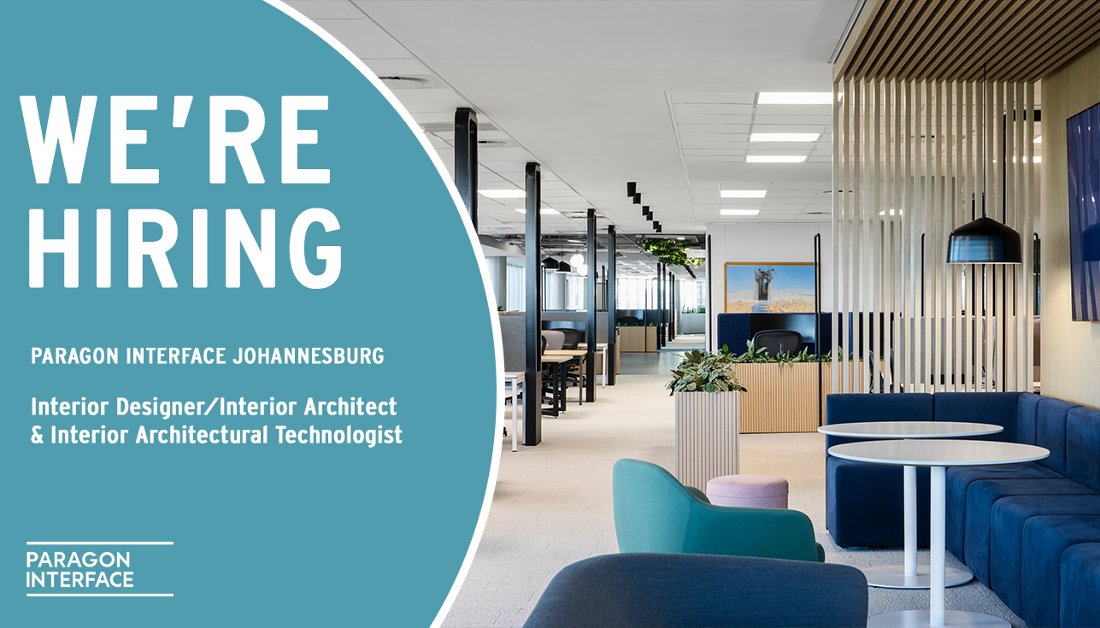
Paragon Interface Johannesburg is looking for an Interior Designer/Interior Architect with 3 to 5 years’ experience as well as an Interior Architectural Technologist with 3 to 5 years’ experience.
Not just anyone can fill this position, if you can answer the following 5 questions, then you might be the person we are looking for:
1. Do you believe that inspiration allows for Technical Creation?
2. Is Revit your first Language?
3. Do you need “more” in your career?
4. Are you a “smart” worker and eager to grow?
5. Does Excellence drive your deliverables?
If you have answered yes to all the above, you should apply.
Must haves:
Excellent Revit Experience
Interiors Know How
To apply please send the following:
• CV
• Design Portfolio
• Technical Portfolio
• University Marks
To: joinus@paragon.co.za with the Reference/Subject Line: PIJHB_IA/ID/IAT_02
Th closing date for application is the 15th of April 2022
Hatfield Square design provides ideal social-distancing solution for students
By Paragon Media
- 0
- 0
- News
- 07 Oct
When Paragon Architects designed the facilities at the Hatfield Square mixed-use student accommodation development in Pretoria for owners and developers Respublica and Redefine, it had a variety of social and study options in mind. “Little did we know that this would provide an ideal social-distancing solution during the ongoing pandemic, as the students have a variety of options in terms of the spaces they can occupy,” comments Senior Associate Antoinette Kloppers. These range from reading a book on a hammock to having a small social get-together outdoors, using a small study room, or simply sitting far apart in the study centre.
Catering for 2 200 students in a variety of unit types, Respublica Student Living manages the development. It extends over 51 000 m2 (excluding basement levels), with 3 500 m2 of retail space and a mix of restaurants and line shops facing Burnett Street. With the retail industry and especially restaurants hardest hit by the pandemic, it is anticipated that Hatfield Square will benefit from more foot traffic during the summer months to come.
“As with all buildings besides healthcare facilities and our own homes, Covid-19 has had a significant impact on the development and occupation of buildings. The education sector suffered greatly with lockdown, and most students resumed their studies from the comfort of their homes, just as we had to redefine the home-work balance. The facilities were unfortunately not fully occupied during these times,” explains Kloppers.
Looking back, Kloppers says the entire project was such an incredible team effort. “I am very proud of the beautifully functional end result. It really has taught me that immense budgets do not make successes of projects, but great teamwork does.”
The project was completed in three phases. Blocks A and B are located closest to Hatfield Square, followed by Blocks C and D; the latter being the tallest building in the precinct, and completed last. In order to enhance the sense of micro-communities the four blocks were colour-coded, with each building’s unique colour repeating throughout its floor plates as well as on its façades.
With accessibility as the key driver, pedestrian walkways were introduced on either side of Block D, seamlessly connecting Hatfield Plaza and the Hatfield Gautrain Station. These thoroughfares feature both stairs and ramps, and are therefore also wheelchair-friendly.
“We shaped the space to cater for both students and the general public, encouraging flow and interaction,” highlights Kloppers. For example, the line shops were leased to tenants addressing student-specific needs, together with a few restaurants. This mix resulted in an extremely inviting and welcoming frontage.
While student accommodation in the Hatfield area is quite saturated at the moment, Kloppers points out that there will, however, always be a need for student accommodation where education facilities expand. In terms of the way forward, post Covid-19 there will be an increased demand for facilities that provide comfort and a variety of functional spaces.
Paragon Interface, Zutari achieve another rating first for 1 Discovery Place
By Paragon Media
- 0
- 0
- News
- 20 Sep
One of only a handful of 6 Star, Green Star As-Built rated buildings, 1 Discovery Place adds 5 Star, Green Star Interiors v1 certification to its accolades
The iconic 1 Discovery Place in Sandton has been awarded a 5 Star, Green Star Interiors v1 certification by the Green Building Council of South Africa (GBCSA). It is also only one of a handful of projects to have achieved a 6 Star, Green Star As-Built rating. Interior architecture company Paragon Interface, part of the Paragon Group, was responsible for the fit-out, while leading consulting engineering and infrastructure advisory firm Zutari provided mechanical and ESD (Environmentally Sustainable Design) services.
“It was always such a team effort. We could not have completed this project successfully without the cooperation and collaboration of the entire profession team,” says Claire D’Adorante, Director at Paragon Interface. She cites the interior rating as a fantastic achievement. “An interior rating is an in-use, over-time kind of rating. It is especially meaningful, as the building is functioning the way it was intended. Three years after handover, and it is still going great.”
“Three years after handover, and it is still going great.” – Claire D’Adorante, Director at Paragon Interface
“It is the largest building we have come across in South Africa that has ever been certified. It is really a phenomenal achievement from a design and a rating point of view,” says Yovka Raytcheva-Schaap, Associate, ESD Consulting & Project Management at Zutari, who first became involved with the project in 2013. “It has been a long process, from the initial concept design through to construction, commissioning and rating.” The interior rating process only occurs after the building is constructed, with Discovery taking occupation in early 2018.
“It is the largest building we have come across in South Africa that has ever been certified.” – Yovka Raytcheva-Schaap, Associate, ESD Consulting & Project Management at Zutari
Raytcheva-Schaap adds: “In the early stages, we saw the commitment of developers Growthpoint Properties and Zenprop in terms of the base build rating, and now we are seeing Discovery’s commitment as well with regard to the interior rating. To my knowledge, there are only a couple of buildings that have achieved both design and As-built ratings, and then continuing the process for the fit-out rating.”
Involved initially with the base build rating, it was a natural progression for Zutari to continue with the certification process. “There were a lot of design features we could leverage from the base build for the interiors rating,” says Raytcheva-Schaap. Paragon Interface worked closely with Zutari in terms of targeting the necessary points.
“The fundamental difference here is that we looked more at the interior environment and how it affects the occupants, so it has a slightly different focus. The base build rating is about the wider environment, the location of the building, the construction process, base build energy and water and materials use solutions, while the interiors rating covers, in more detail, indoor environmental quality for inhabitants, acoustics, ergonomics, greenery and reuse, among other elements,” points out D’Adorante.
The most important category in the interior rating is the selection of materials for the fit-out, not only from an aesthetic point of view, but also the fact that the materials selected are certified by third party eco-certifiers. “Just to give an understanding of the order of magnitude of the undertaking, we had about 50 000 pieces of furniture installed in the building, of which about 35 000 were reused pieces. That is largely what contributed to the high score in the category of material usage. It was really a very good decision for Discovery to reuse existing furniture and refurbish wherever possible,” says Raytcheva-Schaap.
Of the 50 000 pieces of furniture installed, 35 000 were reused pieces.
“It is a landmark project that has become an icon. I think it has been very sensitively handled in terms of environmental reuse and budgeting, for example. The perception is that it was a costly fit-out, but it is important to note that there was a lot of frugality where it needed to be, offset with some new items in certain areas. Obviously bringing people together from five different buildings is a financial cost-saving model. Hence the interior rating really reflects how well thought-out the project was and what the team managed to achieve,” says D’Adorante.
Raytcheva-Schaap concurs: “The way the building has been designed to bring people together under one roof, and the manner in which environmental quality is addressed, is phenomenal. It also provides so much utility for the people working there. From the functional set-up of the office areas to the various eateries, studios and shops that satisfy employees’ needs while working, it is just incredible.”
As a major player in the health insurance industry, it was vital for the client to have the building fully activated from a physical point of view. In terms of the base build, this includes people using the striking staircases rather than the elevators. The interior, on the other hand, has been designed to encourage a continuous flow of people around the different functional areas.
The roof level, as well, includes a running track and other sports facilities such as yoga decks and mini courts. “The views from the roof of the building over Johannesburg are remarkable. This is again to make it so that people really enjoy being there. It is one of the buildings that has really pushed that design envelope towards occupants’ health and well-being,” says Raytcheva-Schaap.
While the Covid-19 pandemic did not have any impact on the rating process, the mechanical services implemented definitely contribute to the building running in a mode where the air quality is as high as possible and fresh air is well-circulated throughout. “That makes it possible for the building to function under Covid-19 conditions, with less risk to the people working there,” says Raytcheva-Schaap.
“It has definitely set a benchmark that has been used as an example for so many other projects as well,” says Jacques Prinsloo, Senior Project Interior Designer at Paragon Interface. “If you consider the large number of people who worked on this project over the years, it was a major learning curve for all involved. I do not know if we had the luxury to consider the actual scale of the building when we embarked upon the project; we just had to embrace it and work through the process to get to where we are today.”
And that is a point no one could have foreseen at the outset of the project: 1 Discovery Place being transformed into a mass Covid-19 vaccination site. “That has been very interesting to see, as the large atrium spaces are ideally geared for that. They were originally designed as spaces for people to come together. And now look at what is being achieved, with the building providing a social service. It is a wonderful conclusion to the story of this project.”
Raytcheva-Schaap says the successful conversion demonstrates the inherent flexibility and adaptability of 1 Discovery Place. “This will be more and more necessary going forward. The Covid-19 pandemic has changed everything so much, especially in the context of working from home. Many existing office buildings need to be repurposed as a result, and if this can be achieved cost-effectively and efficiently, the owners will see increased utility in future.”
Pecanwood College Hartebeespoort: Paragon Architects completes major upgrade and extension
By Paragon Media
- 0
- 0
- News
- 15 Sep
The recently completed Pecanwood College project at Hartebeespoort in the North West Province has allowed the school capacity to expand by an additional 350 scholars. Pecanwood College is a brand of ADvTECH, Africa’s leading private education provider. The upgrading of existing facilities and infrastructure has transformed the space into a welcoming and exciting learning environment ready for future generations.
Paragon Architects was tasked with the conceptual design of the new build at the end of last year. Construction commenced on 25 March 2021, with the project handed over for practical completion at the end of August, reports Project Lead David Cloete. The Paragon team included Director Estelle Meiring and Student Architect Tayla Summerton.
The project consisted of a newly-built preparatory school and ‘learn-to-swim’ pool, as well as renovation of the high school entrance, conversion of dormitories into new apartments and the upgrading of existing dormitory facilities. The development included 14 new on-grade parking bays and a drop-off area, a sportsfield, JoJo tanks and signage.
The design aimed to preserve the existing architectural aesthetic of the school, namely face brick band base, covered connecting corridors and tiled pitched roofs, while incorporating modern fixtures and finishes to create an enduring learning environment. The use of tactile materials and the integration of indigenous landscaping, surrounding views and natural light throughout the scheme creates a sense of connectedness to the outdoors.
“The design aimed to preserve the existing architectural aesthetic of the school.” – David Cloete
“There were no real challenges posed by preserving the existing architectural heritage. However, due to the sloping topography of the site and design layout of the new preparatory school, which corresponded with the existing school’s layout, we had to break the new development up into different levels, and add gradual ramps between them. This, in turn, resulted in a stepping roof system as well,” explains Cloete.
The 2 085 m2 new preparatory school consists of 13 classrooms, all with storage facilities; a laboratory, entrance atrium, office spaces, staffroom, staff ablutions and ablution facilities for junior and senior boys and girls. Interconnecting covered corridors create central courtyard spaces. The entrance atrium is enclosed with performance glazing shopfronts with charcoal aluminium that demarcates the entrance of the new development.
The central 8-m-wide corridor extends from the entrance atrium towards the new sportsfield, accentuating views towards Hartbeespoort Dam and the mountainous landscape in the distance. The new structure is established along the street frontage for maximum exposure to any passersby.
The high school entrance renovation consisted of enclosing the entrance atrium space with high-performance glazing shopfronts and louvres for natural ventilation. The newly-enclosed area created additional waiting space for visitors. Placing illuminated signage featuring the school’s logo at the entrance of both the high school and new preparatory school clearly defines the structure’s entrances at night.
The new ‘learn-to-swim’ pool consists of a covered, 1.4-m-deep, 5 m x 10 m pool with a surrounding walkway, ablutions, changerooms and a pathway connecting to the existing pre-primary school area. A Clear-Vu fence surrounds the new development to ensure safety at all times.
On the ground floor of the boys’ dormitory building, the renovation saw construction of ten dormitory rooms housing 21 scholars, a collaborative study area, boys’ and girls’ ablution facilities and a connecting four-bedroom apartment. The renovation included an additional entrance, modern fixtures, finishes and joinery. On the first floor of the boys’ dormitory structure, the renovation saw the conversion of three existing classrooms to two apartments, namely a one-bedroom and a three-bedroom apartment respectively.
While the architecture and interior architecture firm is more widely known for iconic corporate offices such as 144 Oxford Road, Discovery Place and the new Sasol head office, Paragon Group has a number of educational facilities under its belt, such as the Torah Academy Girls High School in Johannesburg, as well as student accommodation projects like Hatfield Square in Pretoria.
Paragon Group announces latest associate promotions
By Paragon Media
- 0
- 0
- News
- 06 Sep
Paragon Group, specialising in architecture and interior architecture, has announced a series of promotions to associate level. From data centres to sports complexes and iconic office developments, the Group’s diverse experience and expertise continues to stand it in good stead in the property and construction market, which has been hard-hit by the Covid-19 pandemic.
“I am very grateful that I not only get to grow in my calling, but have the privilege to cultivate the careers of my colleagues. My success is only measured by their success,” says Antoinette Kloppers, Senior Associate at Paragon Architects.
“I am very excited about the new challenges posed by my senior role. I will continue to strive for excellence in design and to learn and grow every day, while continuing to mentor the younger generation of talented designers,” says Kirsty Schoombie, Senior Associate at Paragon Interface.
Anthony Karam says his new role as Associate at Paragon Interface is “a great opportunity to further develop within the design fraternity. I am proud to be part of our constantly evolving knowledge base and excited to keep pushing the boundaries at the forefront of South African excellence in interior design on the world stage.”
“I am excited to start a new role at Paragon Architects,” says Associate Kim Newell. “I look forward to solving the challenges that lie ahead with the great team we have.”
Paragon Interface Senior Associate Kirstin Cavanagh concurs that “it is the dynamic people in our office that make every day less ordinary and more inspiring.” Kirstin has progressed from a candidate architect straight out of university 11 years ago to her latest role.
“I feel privileged and excited to take on this responsibility for Paragon Architects. It is going to be challenging, but I look forward to it,” says Senior Associate Taz-Wynne Superman.
“I guess it is a bit surreal to look at the journey, as you are always learning and being mentored, and somewhere in that time you start to become both a mentor and mentee. In that sense, I look forward to the challenges ahead and solving them with a great team and support system,” says Paragon Architects Associate Jarred Pincus.
“I am very thankful that my skills and value have been recognised. It means a lot to me and my family. I am very excited to be moving up to the next level, learning new things and to continually support Paragon Architects while doing the work I love,” says Associate Warren Wesson.
Mixed-use developments drive trend for convenience and integration
By Paragon Media
- 0
- 0
- News
- 16 Aug
Mixed-use developments are a growing trend in the residential property development market because they reduce travel time for residents and offer more convenience, choice and an integrated lifestyle. On the part of developers, the decision-making involved may be more complex, but this can be balanced against more robust income models. “All in all, mixed-use developments represent a positive alternative to our disintegrated, mono-functional South African cities,” comments Paragon Group Director Henning Rasmuss.
The Melrose Arch development in Johannesburg, in which Paragon Architects participated as a start-up design practice, first prodded developers into considering mixed-use precincts as an alternative model. However, complacency and the resistance of banks and their credit risk committees to merged and mixed income models have scuppered many a mixed-use project in the past. The contracting economy and more demanding, urbanised and car-less, younger middle-class consumers are changing that though.
Rasmuss points to many capacity constraints affecting development at the moment. Affordability limits are squeezing the number of square metres, coupled with young upper middle-class consumers still opting for traditional first-time home ownership. This is also partly due to the fact that the traditional South African city has working, living and playing areas neatly separated by vehicle corridors.
“Overlay apartheid spatial planning onto this, and we end up with dysfunctional cities that are expensive, inefficient and alienating. Some of the mixed-use trends derive from consumer demand and a new perception of city life as something desirable with high amenity and social value,” highlights Rasmuss.
A major driver of mixed-use developments in South Africa is the massive shift in ownership of B-grade and C-grade office buildings due to Covid-19, many of which are now available for residential redevelopment. “There is not much else one can do with those workplaces left behind by shrinking companies. Costs of transport, non-available infrastructure budgets and a general demand for urban convenience are driving housing demand to shopping malls, which have additional challenges of underperformance and can support additional bulk off existing infrastructure,” stresses Rasmuss.
Bulking-up developments on top of or next to shopping malls and their parking lots can insert additional housing adjacent to malls. Associated trends include micro-living in highly-serviced buildings, highly-branded low-cost urban renewal projects and, for the mass market, price-point-driven walk-up apartments, with student housing falling somewhere into the low-cost refurbishment market.
An example of a contemporary large new-build mixed-use project is the Harbour Arch precinct in Cape Town, which Rasmuss acknowledges “is probably leading the way.” The 5.8 ha Harbour Arch development by the Amdec Group will be home to six individual tower blocks with a total 200 000 m² of usable space, making it the first and largest mixed-use development of its kind in the Cape Town central business district.
It is comparable to the Melrose Arch precinct in Johannesburg, and will encapsulate the principles of New Urban living. This presents opportunities for people to live, work, play, relax and stay in a safe, convenient, enjoyable and sustainable community-focused environment. Expansions and redevelopments in the Cape Quarter similarly show that there is viable demand.
While Paragon is not involved with Harbour Arch, there are a number of mixed-use developments that are on the Group’s radar. Also in Cape Town, it is working on an intricate site in the City Bowl that encompasses varied development functions. A super-flexible masterplan is afoot at the Newlands Rugby Stadium, while in Nelson Mandela Bay the architecture and interior architecture group is working on a mixed-use precinct centred around sport as a connector. “It is interesting that open spaces are becoming desirable and valued, especially in tough South African urban settings,” notes Rasmuss.
In Malawi, Paragon Group is working on a mixed-use precinct in Lilongwe adjacent to the airport, based on the Millennium Development Goals as a design driver. In Angola, it is being commissioned to design a super-integrated business and living complex in the middle of Talatona. “That project will have ‘a little bit of everything’ and opens up opportunities for multiple smaller co-developers, breaking the mould of dominant family-based control of major projects in that city. It is a large site that can comfortably be phased,” elaborates Rasmuss.
From a continental perspective, Rasmuss points to the traditional East African super-mixed-use multi-storey retail and residential complexes that line so many streets in Kampala and Kigali, and also Accra and Dakar. “There are definitely lessons here about what can be achieved,” he adds. Hence mixed-use is quite natural on large parts of the continent.
“It is important to think of mixed-use as ‘the natural normal’, and not as a new and risky thing. It is how people want to live – naturally. What happened under the tenets of modernist planning is that people across the world had their lives disaggregated and distorted. There is hopefully now a reversal to ‘real cities for real people’,” predicts Rasmuss.
Paragon Architects designs integrated plant for leading German medical device and pharmaceutical company
By Paragon Media
- 0
- 0
- News
- 04 Aug
When German multinational B.Braun decided to establish a new integrated pharmaceutical plant in Longlake 20 Business Park in Johannesburg, property developer Zenprop turned to Paragon Architects South Africa (PASA), part of the Paragon Group. Representing one of the most significant industrial investments in South Africa in recent times, the project included office, laboratory, warehousing and production spaces, with a total gross area of 6 435 m2.
Situated on a highly-visible Greenfield site along the busy Longmeadow Boulevard, the facility also overlooks the picturesque Modderfontein reserve. PASA Architect Benjamin Chihota points out that industrial buildings tend to be large monolithic structures, and that the intention on this project was to humanise the scale of the facility while maintaining a simple and coherent architectural language.
The best means to achieve this was by using dynamic forms to reduce the overall scale. For example, breaking up large masses into smaller forms resulting in fragmented roof and façade forms and heights. This de-emphasises the scale of the facility within a largely under-developed landscape, while making use of high-quality and robust materials that are easy to maintain.
“The brief for an integrated pharmaceutical plant made for a complex typology because there are so many layers before you even get to the architectural design itself,” comments Chihota. Instead of a typical industrial facility, PASA was determined that the end result be a signature project that not only complements the surrounding business park aesthetic, but which also expresses the corporate identity of B.Braun itself.
“As a multinational, there is obviously an existing brand image that we needed to maintain. This meant developing a specific design language for the exterior, interior and the landscaping, but obviously still keeping within a South African context. Being one of the few new projects of this type and size built in South Africa to date, it really gave us an opportunity to showcase what we are capable of in the industrial sector,” elaborates Chihota.
The design process began in 2018, based on extensive consultation with the client and tenant. Construction commenced on-site in January 2019, with practical completion achieved in April and works completion in November 2020. Despite a delay due to the restrictions imposed by the Covid-19 pandemic, PASA saw the project through to its successful conclusion.
Planning and coordinating the functionality of the facility was perhaps the biggest challenge. Apart from the office and laboratory component, there is also warehousing space for incoming raw materials and outgoing products. Changerooms for workers to change in was also critical, in addition to the production component itself, which is the heart of the facility.
“In terms of the actual architecture, firstly we had to keep the client in mind and the highly specialised nature of this facility and its specific requirements. We also had to adhere to the development guidelines of the business park itself, while at the same time staying true to the design ethos of PASA and what makes us unique as a practice,” highlights Chihota.
The design process involved fragmenting the vertical and horizontal extents of the facility to reduce its scale. To give depth to the building mass, elements of the roof and façade were pulled out. To give the building envelope a rhythmic pattern, the roof sheeting and façade cladding’s contrasting colours stepped-in sections allowed for fluid connectivity that merged with the walls and wrapped around the windows. “That comes across in different ways in both the office and the warehouse. With most projects, you start out with an initial idea that invariably goes through different iterations, but ultimately it is a concept you stay true to right up to the final design,” stresses Chihota.
The major engineering challenge was coordinating the different services. Most projects require standard wet, electrical, fire and HVAC services. However, B.Braun had hi-tech pharmaceutical process equipment with very specific functional requirements thrown into the mix. “We really worked together well as a professional team in overcoming all of these different challenges,” notes Chihota. “The developer was very open to our ideas and willing to take them onboard. While we have a longstanding relationship with Zenprop that we are continually nurturing, it is equally important that we establish close ties with other consultants as well.”
The Paragon Group has a growing footprint in the industrial sector, which Chihota sees as a burgeoning market going forward. “The e-commerce sector is booming, as can be seen by the increasing demand for warehousing space, while the demand for commercial office space is stagnant. What gives us a leading edge in this sector is our reputation for delivering on time and within budget, being professional at all times, and being accessible to our clients,” he concludes.
Professional Team
Developer: Zenprop
Tenant: B.Braun
Project Manager: Capex Projects
Architect: Paragon Architects South Africa (Project Director Thulani Sibande, Project Leader
Benjamin Chihota and team members Suvaniya Pillay and Kirti Mistry)
Quantity Surveyor: Schoombie Hartmann
Civil and structural engineer: DG Consulting Engineers
Mechanical Engineers: WSP
Electrical Engineer: Topack Consulting Electrical Engineer
Fire Consultant: Chimera Fire Protection Consultants
Wet Services Engineer: Izazi Consulting Engineers
Paragon Group remains committed to developing new talent
By Paragon Media
- 0
- 0
- News
- 28 Jul
Bringing in new blood is important to ensure sustainability and creativity throughout the architecture profession. Over the past few years, the Paragon Group has committed itself to develop young talent by employing a number of new graduates each year and training them until they become fully-registered professionals.
“This facilitates their growth mindset and builds mental toughness. It assists in diversifying their goals, whether to become project architects, leaders in principal agencies, or design-orientated,” comments Thulani Sibande, Director of Paragon Architects South Africa (PASA).
As part of the Paragon Group design businesses, PASA shares the same sentiments about staff training. It always strives to ensure its staff members are fully trained in order to achieve the necessary compliance required by the South African Council for the Architectural Profession (SACAP), the industry governing body.
“Most importantly, we ensure that all our young architects are given an equal opportunity to run and manage upcoming new projects, while enjoying full assistance from directors or senior colleagues to ensure deliverables and consistency throughout the duration of the project,” explains Sibande, who was a 2019 judge at the 2019 & 2020 Corobrik Student Architecture Awards, held in the form of a hybrid virtual event in early June.
The winners were announced at a first-ever hybrid event in Johannesburg on Thursday 10 June. The 2019 awards ceremony had to be postponed due to Covid-19, but Corobrik adapted and instead decided to host the 2019 and 2020 awards ceremonies together in a single exclusive event.
“It has been a privilege to be part of the 2019 jury panel. It was such a great opportunity to see our upcoming young architects portray their talent and pave the direction in which architecture is heading,” comments Sibande. He adds that longstanding competitions such as the Corobrik Student Architecture Awards, which has been running for over 30 years, are critical to nurturing young talent in the architectural community.
While Covid-19 has definitely resulted in the Paragon Group restructuring certain elements of its business, its mandate to mentor and develop new talent remains consistent in order not to disrupt day-to-day deliverables. Sibande adds that work exchange opportunities remain a challenge in the current economic climate, fuelled by the ongoing pandemic, but enquiries remain in place, which is promising.
“If such opportunities come our way, we would definitely love to see our young architects exposed to working in other parts of Africa so as to understand the dynamics of working on the continent. My advice is that they should go for it, as this is a rare career where one can solve problems by being creative. Architects are constantly solving problems, as it is such a challenge to consider all aspects of a building’s requirements, from the design to the structural elements, aesthetics and much more,” Sibande concludes.
Paragon remains stalwart in its support of gender parity as it navigates the Covid-19 crisis
By Paragon-1
- 0
- 0
- News
- 20 Jul
It is so important to demonstrate opportunities for career advancement at present. “Morale throughout the profession is not at its best during these extraordinary and trying times, yet we continue to grow and excel and produce great work for our clients,” says Paragon Interface Senior Associate Kirstin Cavanagh.
Recently appointed to her new role, Kirstin perceives this as a much-appreciated milestone along her career path. “On a personal level, it is a great achievement as it really confirms that one can continue to progress in a career and establish a family simultaneously – something that I was afraid would not be possible for me when I became a parent two years ago.”
Paragon Interface, the interior architecture company of the Paragon Group, has a particular expertise in workplace strategy. Covid-19 has motivated many organisations to start thinking about what the office space means and how the office will, should and could be used going into the future.
“This has given us great opportunities to explore new ways of working with our clients, as they have become a lot more open to ideas around flexible and hybrid work practices. The challenge is that we do not know how long the coronavirus is going to be around for, and exactly what we should be planning for in that regard – flexibility and agility are therefore key considerations.”
Kirstin adds that family structures and home and work life have all been disrupted by Covid-19. “I have tried to keep things like daily routines as normal as possible to give myself some semblance of control. I have also managed to keep extremely busy, which is always a great coping mechanism when things are turned upside down.”
Pull Quote
“This has given us great opportunities to explore new ways of working with our clients.” – Kirstin Cavanagh
“I always wonder if I am really making a difference and reaching my goals,” reflects newly-appointed Paragon Architects Senior Associate Antoinette Kloppers. “This great recognition and the congratulations I received have brought a refreshing perspective on how I have grown in my career. The world is going through a lot of challenges at the moment. Paragon sees those challenges as opportunities to grow and evolve, instead of stagnating due to difficulties.
“In the past year, we have had to rethink everything. We have had to create opportunities and new ways of learning and mentoring, especially when you have to explain math to your child on equations you have forgotten about. One cannot grow without trials, and as much as we faced many difficulties, you can find at least one lesson learnt in every challenge faced.”
A notable achievement for Antoinette is that, after five years of balancing work, family life and studying, she has completed her studies with the Association of Arbitrators and is now qualified as an arbitrator. Her message to her fellow female colleagues and the profession on the occasion of Women’s Day 2021 is: “Work hard and follow your own unique growth path.”
Pull Quote
“We have had to create opportunities and new ways of learning and mentoring.” – Antoinette Kloppers
Kim Newell has just been appointed an Associate at Paragon Architects. “From a personal perspective, I am really proud. It means a lot to me to be recognised within the company. In terms of my professional career, it gives me the opportunity to grow further and contribute towards growth at Paragon. I am looking forward to the journey ahead. The last year-and-a-half has been tough for the industry as a whole, and the entire team at Paragon has worked incredibly hard.”
Remote working has been challenging, notes Kim. “As architects, we are so used to sitting around a table brainstorming design challenges. We have had to rethink the way we do this, and working over video calls is not the same. As we slowly move back into the office, this will become easier. Balance is not easy – it is more about juggling priorities. Exercise and time off help me manage stress levels.”
On the occasion of Women’s Day 2021, Kim reflects how fortunate she is to work at an architectural firm that prioritises gender parity. “There are strong women in the team who chose to build each other up rather than break each other down – this is not always the case in the construction industry, and something we should work towards.”
Pull Quote
“As architects, we are so used to sitting around a table brainstorming design challenges.” – Kim Newell
Newly-appointed Paragon Interface Senior Associate Kirsty Schoombie says she is very excited about the challenges presented by her senior role. “I will continue to strive for excellence in design, to learn and grow every day, while mentoring the younger generation of talented designers. As we navigate through this uncertain journey, the recognition shown is of paramount importance. Paragon has a culture of growth and collaboration that pushes individuals such as myself to climb the ladder and better ourselves every day.”
Kirsty acknowledges that Covid-19 has brought about both opportunities and challenges for the team. “We have pulled together during this time to build a stronger base, ready to face the future.” In this regard, hybrid working has brought about a new way of collaborating with both the team and clients.
“We have completed several beautiful interior fit-outs, secured additional clients, and retained strong client relationships in these trying times. Paragon Interface has researched the new hybrid way of working in depth and is busy implementing it for several clients, which is both challenging and an exciting new way of design and communication.”
As a company, Paragon Group strives to remain positive and productive, while keeping the creative juices flowing. “Our staff are motivated through constant collaboration with our clients and consultants, as well as the team. We have endeavoured to instil a balance between work and home lives by creating a strong support system within the group.”
Kirsty concludes: “As a woman in the architectural profession, I endeavour to accomplish all of these goals on a daily basis, with my team and the larger female community of designers. There is no limit to what we as women can accomplish.”
Pull Quote
“There is no limit to what we as women can accomplish.” – Kirsty Schoombie
Copyright © 2022 Paragon Group - South Africa. All Rights Reserved.

